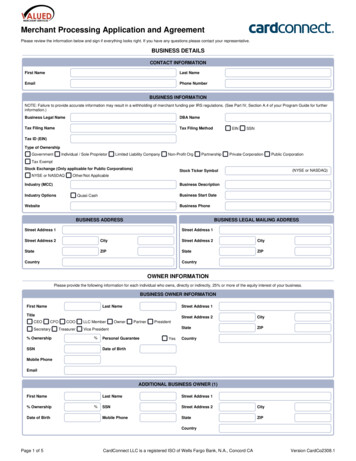
Transcription
JSO Treatment Workbook
MINDWORKS Documentation System · WorkbookPersonal InformationFirst Name:First Date of Treatment:Charges:Name of probation officer:Conditions of Probation: Length of probation: Community services: Date to register: 2004 Mindworks
MINDWORKS Documentation System · WorkbookWorkbook IntroductionThe MINDWORKS Treatment StorySex offender treatment is like this When you are offending, you take your victims into thissecret room that nobody knows about, and that’s where it happens. Then after you are doneyou leave that room, shut the door and pretend like its not there. But it happens again andagain. After each time you promise yourself that you won’t go to that room again, but youcan’t stop yourself.Then your worst nightmare comes true. You get caught and the police, or your parents dragyou up to the secret room and say, “See that’s the sex offending room !!!!” At first you deny it,but eventually under all the pressure you break down and admit the truth. They take you tocourt and the Judge tells you that you have to go to therapy to clean out that room.Therapy involves goingup into that secret room,opening the door, turningthe light on and lookingin all the boxes that arestrewn across the room.Therapy involves going up into that secret room, opening the door, turning the light on andlooking in all the boxes that are strewn across the room. Each box is a person you abusedand there are boxes within boxes. You hate being in this room, it feels horrible, smells horribleand you just want to run and hide. You try to avoid the shame of the room; You go in theroom but don’t turn on the light, you stand in the doorway and talk about the boxes withoutgoing in, or you go in the room but close your eyes so you can’t really see. None of thesetactics work because it’s a funny shaped room and you can only see how many boxes thereare if you go right into the room and look in all the corners. It takes a lot of courage to go inthis room. Eventually you realize you owe it to the people you have hurt and who love you togo into the room, turn on the lights, look in every corner and and open up all the boxes. Thenyou have to tell your parents about those boxes and what is in them. This is the hardest part,it makes the abuse more real.You begin to change, you stop fighting the therapy and start to really clean up your room.Admitting to all the boxes is a start, but not enough. You have to figure out how this roomgot there in the first place. You didn’t plan on building this room. You didn’t want this roomto ever exist but here it is, full of rancid smelling boxes. Your family needs to know why thisroom exists. They can’t relax until you are able to explain how their son built such a horribleroom. To do this you need to look at the foundations of your house, how it was built and howit became the house that you are Once you have opened all the boxes and once you have looked at the foundations of thehouse, its time to clean up your act. You finally get to take the boxes out to the trash, oneby one. Eventually the room is empty. There are memories in that room, not just about theboxes but also how you changed by cleaning that room out. You have been transformed froma person with horrible dirty secrets to a person who is honest and open, with integrity. Finallyyou get to close off that room, you lock the door and seal it off, never to go back but knowingthat it will always be there. 2004 Mindworks
MINDWORKS Documentation System · WorkbookJuvenile Sex OffenderTreatment WorkbookPretreatmentchapters1 2 3 4Sex offender treatment is difficult and challenging.This section is designed to help prepare you for tasksahead of you and help you understand what yourtreatment actually involves.Ownership5 6The most important part of treatment is that you takeresponsibility for your behavior. In other words youacknowledge and admit the full extent of your abusivebehavior. The exercises in this section help you “own” theoffenses. Once you own them you will be able to fix them.Trauma Issues7 8 9Your personal trauma is a significant force behind yourabusive behavior. This section helps you identify the factorsbehind the abuse. It is important that you address theseissues otherwise you will always be fighting the temptationto reoffend.Ongoing Treatment Issues10 11Sexual offenses result from the build up of daily experiencesof failure and frustration. This section will help you identifyyour ongoing problem behaviors. In addition, this stagebegins to address your need for a healthy self esteem andimproving your social skills.Clarification12One of the problems with sexual abuse is that the victimsand parents feel responsible and blame themselves for theabuse. In this section you will prepare to face the people youhurt acknowledge your responsibility and finally apologize.Relapse Prevention13Your therapy will have been a waste of time effort andmoney if you reoffend. This is the final section and helps youdevelop a plan of how you and your family will respond ifthere are indicators that you are close to reoffending. 2004 Mindworks
MINDWORKS Documentation System · WorkbookLayout of the Juvenile Sex Offender Treatment WorkbookThe icon on your left graphically represents sex offender treatment and the stages thatare involved. The gray line with a circle is a map of treatment. The small blue circles represent the stages in treatment. The gold square represents the stage that you are working on.This icon allows you to be clear about how far you have come in treatment and howfar you have to go. You will notice that there are three stages of treatment that arepart of the circle. These stages are Ownership, Trauma and Ongoing issues. They arearranged in a circle for three reasons:1. The three stages are the core of sex offender treatment and need toresolved before you can proceed to Clarification and Relapse Prevention.2. Everybody is different; some people start with ownership, while others needto deal with their own trauma or ongoing issues first and then move ontothe other two sections.3. Treatment is not linear. Frequently people have to go around the circlea number of times before it is time to move onto Clarification andRelapse preventionThrough out this workbook you will see this icon and so that you will easily be able toknow where you are at in the treatment process 2004 Mindworks
MINDWORKS Documentation System · Workbook · 1Chapter One:Treatment ContractBy signing this contract I am acknowledging that I have engaged in sexually abusivebehavior and am seeking the help of the MINDWORKS Juvenile Sex OffenderTreatment Program. While I am in this program I will refrain from the followingbehaviors.1. Pornography of any kind(includes books CD’s, DVD’s, magazines or internet sites)2. Sexually explicitly movies or music3. Sexual contact; consensual or non consensual4. Phone sex or cyber-sex5. Criminal activities or probation violations6. Unsupervised contact with children under the age of 127. Baby sitting or supervision of children8. Drug and alcohol use9. Contact (direct or indirect) with victims or codefendants (without approval fromtherapist and Probation officer)10. Unsupervised use of internet, chat rooms or e-mailI recognize that if I break any conditions of the contract, that my Probation Officer willbe informed and I may also be terminated from the treatment program.Client: Date:Parents: Date:Therapist: Date:Probation Officer: Date:Chapter One: Treatment Contract 2004 Mindworks
MINDWORKS Documentation System · Workbook · 2Chapter Two:Treatment GoalsA Picture is Worth a Thousand WordsSometimes it can be hard to put it into words how you feel about you situation. Spenda few minutes drawing a picture which represents how you feel about being labeled asex offender and what that’s like for you to go through the court process.Spend a few minutes drawing a picture which represents how you feel about being labeled a sex offender and what that’slike for you to go through the court process.Chapter Two: Treatment Goals 2004 Mindworks
MINDWORKS Documentation System · Workbook · 3This is difficult time. You are facing a great deal of anxiety and being asked to do somedifficult tasks. However, it is very important that you spend some time working ontreatment goals. It will have a number of benefits:This is where yourworkbook really starts:writing down clear,concise goals that youwant to achieve intreatment. You will take the first steps in clearing up the mess you are in. One of the keys to success in life is being able to set goals and then achieve them.One of the secrets is taking the time to write down some clear concise goals.Research has demonstrated that you are 60% more likely to meet your goals if youwrite them down. This is where your workbook really starts: writing down clear,concise goals that you want to achieve in treatment. By doing this you will have made asignificant step in achieving them.A word of caution: Although writing down your goals may appear to be a simple task, itis not an easy task and you will probably have to write and rewrite your goals until theyare clearly stated.As a starting point, use this box to write out things that you don’t like about yourself and that you know you need to change.Allow yourself to write down anything. Don’t worry about how it comes out or how relevant it is to treatment. If it’s a problemwrite it down. If you think you are fat, write it down. If you hate school, write it down. If you are always angry, write it down. Ifyou want to figure out why you offended, write it down. If you want to fix this mess, write it down. If you think life isn’t fair andyou are being picked on. you guessed it! Write it down. This is the brainstorming stage of treatment where you start to figureout what it is you need to change Chapter Two: Treatment Goals 2004 Mindworks
MINDWORKS Documentation System · Workbook · 4Now put a star by the five problems which are most important to you (they will makethe biggest improvement in your life if you solve them).Now restate these problems by turning them into goals that are positive statements:1.2.3.4.5.Now in order to make these goals effective its important to make them specific, sobelow add the details, like who will do what, where and when it will happen.1.2.3.4.5.Chapter Two: Treatment Goals 2004 Mindworks
MINDWORKS Documentation System · Workbook · 5Finally a goal needs to be measurable. You need to know when you will have achievedyour goal. so write down some indicators that will show that you have met your goal1.2.3.4.5.Chapter Two: Treatment Goals 2004 Mindworks
MINDWORKS Documentation System · Workbook · 6Chapter Three:Treatment ObstaclesTreatment ObstaclesSex offender treatment is challenging and it is natural to “fight” some of the tasks thattreatment involves. While at the start of treatment it is a normal reaction to fightthis process, It is important that you overcome this tendency, otherwise you will failtreatment. In order to move forward, it is useful to identify your obstacles to treatment.The logic is simple; how can you overcome an obstacle if you don’t know what it is?One way of figuring out your obstacles is to ask yourself “What am I afraid of?” orWhat is my greatest fear about what treatment involves?”. It may be you are afraid ofhow your parents may react, or you are afraid of the secrets you need to bring out andtheir consequences, or that your friends might find out about your situation. One thingis certain; Everybody has treatment obstacles. What are yours?Make a list of seven things that you find difficult about treatment.1.Ask yourself,“What am I afraid of?”2.3.4.5.6.7.Chapter Three: Treatment Obstacles 2004 Mindworks
MINDWORKS Documentation System · Workbook · 7Chapter Four:Newspaper ArticlesThe media is full of stories on sex offending and public opinion is ill-informed andoverwhelmingly negative toward sex offenders. You and your family probably agreedwith public opinion until your secret came to light.As a way of exploring some of the issues that this raises for you, research three newspapers articles about sex offenders.Briefly summarize the article and state your opinion about the article. Include copies of the articles.Public opinion isill-informed andoverwhelminglynegative towardsex offenders.Chapter Four: Newspaper Articles 2004 Mindworks
MINDWORKS Documentation System · Workbook · 8Chapter Five:Defenses Part IOne of the things that happens when you start to talk about your sexual behavior isthat it gets uncomfortable. It’s shameful and embarrassing with a host of other difficultemotions. A normal human response to these emotions is to become defensive, to tryand protect yourself from this painful reality. It is important to get past your defensesbecause if you don’t you will spend your time fighting the facts rather than coming toterms with reality and changing it. One of the most common defenses are thinkingerrors. Thinking errors are thoughts we have that we use to make ourselves look betterto ourselves and others. For instance you might say, “Well I know it was wrong, but shewas asleep when I touched her so she wasn’t really affected by the abuse.” This is anexample of a thinking error called minimizing, in which you understate the impact ofyour behavior on the person you abused. There are a number of thinking errors and itis useful to focus upon them so that you can become less defensive and able to takeresponsibility for your behavior.One last point, everybody uses thinking errors. It is a human way of coping withbehavior that is unacceptable and that they are not willing to change. If a person is usingthinking errors they are also communicating that they are unwilling to change theirbehavior.Thinking errors arethoughts we havethat we use to makeourselves look better toourselves and others.Read the list of thinking errors with brief definitions and then answer the followingquestions.1.Blaming: This is a way of making others responsible for your problems. It leads toa build up of resentment toward someone else for “causing” whatever problemsyou have. Examples: “I couldn’t do it because he got in my way,” “The trouble withyou is you’re always looking at me in a critical way,” “She should have told someonesooner,” “She wanted me to.”2.Excuse Making: This is a way of explaining why a situation occurred without takingresponsibility for behavior. The word “because” usually comes right before anexcuse. Examples: “I’m dumb - I couldn’t help,” “I don’t know,” “I was never loved,”“My family was poor,” “My family was rich,” “He did not say stop.”3.Justifying: This is a way of explaining behavior away so that it seem reasonable andunderstandable. Examples: “If you can, I can,” “I was so lonely I had to.,” “She yelledat me, so that is why I.,” “No one listens to me so that’s why I can’t do anything.”Chapter Five: Defenses Part I 2004 Mindworks
MINDWORKS Documentation System · Workbook · 9Lying is a power play andis often used to confuse,distort, and make fools ofother people.4.Redefining: This involves shifting the focus of an issue to avoid acknowledging orsolving a problem. Examples:Question -“Why are you running up and down the hall?”Answer - “I’m not running, I am just keeping time to the music in my head.”Question - “Who put this paper here?”Answer - “It wasn’t there yesterday.”Question - “Where are the books that I borrowed from the library,and left on this desk?”Answer - “John was hanging around here this morning.”5.Super-optimism: This is when a person decides that because he wants some thingsto be a certain way, or thinks it w ill be a certain way, it will be that way. Thispermits the person to function according to what he wants, rather than accordingto the facts of the situation.Examples: If a person expects someone to visit him at his house, he may not takeinto account that the person may have other plans, or possibly the arrangementshaven’t been made. He/she fully expects the person to show up. When theperson doesn’t show up, this gives the him/her an excuse to explode, be angry,or have a tantrum. Super-optimistic people also believe that they can be famous,popular, strong, movie stars, rich, etc. simply by wishing it, and rarely take intoaccount the practical steps along the way.6.Lying: This is one of the most common thinking errors and is used in differentways Lying is a power play and is often used to confuse, distort, and make fools ofother people. There are three basic kinds of lies: Commission - making things up that are simply not true Omission - saying partly what is so, but leaving out major sections Assent - making believe that one agrees with someone else, or pretending,or approving of others ideas to look good when in fact, the person has nointention of going along with this, or does not really agree. People who practicelying can be very deceptive. At different times they can look like they are lyingand be telling the truth. This creates turmoil around them, and people are neversure what is going on.7.Assuming: This involves believing you know what others are thinking aboutwithout clarifying. A person uses this assumption in service of whatever behaviorhe decides to engage in. Examples: A person assumes that other people don’tlike him. This gives him an excuse to blow up, be angry or rob, molest, not pay histaxes, or any other thing he has in mind.Chapter Five: Defenses Part I 2004 Mindworks
MINDWORKS Documentation System · Workbook · 108.“I’m Unique”: A person may believe he is unique and special or that no one elseis like him so that any information that is applied to other people simply doesn’taffect him. The beliefs that go along with this are things such as, “I know everythingand I can handle things alone.” “I don’t need anyone. No one, understands meanyway.” “No one can tell me what to do.” It is common in a prison for a criminalto believe that everyone else is criminal, but not him. A child molester may think,“I’m not like all those other dirty child molesters; I’m different.”9.Fragmented Personality: “If I like it, okay; if not, to hell with it.” It is very commonfor an antisocial person to attend church on Sunday, and beat someone up, orrob someone on Tuesday, and then attend church again on Wednesday. To theantisocial person, there is no inconsistency in this behavior. He believes he is agood person, and is justified in whatever he does. His criminal acts are seen asthings that he deserves to do, get, own, possess, or control. He never considersthe inconsistency between these behaviors.10. Minimizing: A person who minimizes his behavior and actions talks about it insuch a way that is seems insignificant. The goal is to minimize the significance ofhis/her behavior so that it doesn’t look so bad. Examples: “I only molested threechildren, and I could have molested a lot more, but I didn’t.” “I didn’t hand in thepaper when it was due, but I handed in everything else, so it’s no big deal.”11. Vagueness: By being unclear and nonspecific a person avoids being pinned downon a particular issue. He is noncommittal, and uses words, phrases, in a way tolook good to others, but will not commit himself to anything. Examples: Vaguewords such as: “More orless or I think so,” “I guess,” “probably,” “maybe,” “I might,”“I’m not sure about this,” “It possibly was,” etc.12. Calculating: This thinking style is selective, closed-minded and self-righteous. Thiskind of thinking is designed to keep part of a persons life secret, to divert issues.The person believes that no one is smarter than him, and would never think thathe is wrong in a situation.13. Grandiosity: This involves minimizing or maximizing the significance of an issue, andit justifies not solving the problem. Examples: “I was too scared to do anything elsebut sit.” “I’m the best there is, no one else can get in my way.” Underline the ones that you use the most. Show this list to your parents and ask them to underline (in a different colored pen)which thinking errors they hear you using.Your parents will probably like this exercise.It may be more difficult for you, but hey! Nobody said it was going to be easy.Chapter Five: Defenses Part I 2004 Mindworks
MINDWORKS Documentation System · Workbook · 11Chapter Six:OwnershipOwnership of a sexual offense may be one of the hardest things you will ever do. Itwill take a great deal of courage and determination on your part to face being a sexoffender. This task is difficult and there is no getting around this fact. It requires thatyou write and talk about how you sexually abused an innocent person. As part of yourtherapy you will need to talk about your offenses with your therapist and with yourfamily. In order to help you talk about your abusive behavior, it helps to write it downfirst. This exercise will help you come to terms with your offense and prepare you totalk to your family about this very sensitive subject.The good news is that once you take ownership, really take ownership; you havelaid the foundation to become a much happier person, who is able to acknowledgeproblems and solve them before they become out of control. A large part of why youoffendedis that you ignored problems until they became so out of control that theycould not be ignored and demanded attention. Once you learn to take ownership youwill find your life ismuch more satisfying, because you won’t be running from problems.Ownership is also the most important stage of your therapy. It is foundational. By thatwe mean that if your ownership is poor, it limits the rest of your treatment. If you don’ttake responsibility, you will not change. Its as simple as that. You will remain at risk toreoffend and you will not be able to make amends to the people you have hurt.Once you take ownership,really take ownership;you have laid thefoundation to become amuch happier person.So what is ownership? It means to “own” your problem. It involves acknowledging indetail that you sexually offended. The details are critical here, because this is wherethe shame and pain of the abuse lies. Once you disclose the details you begin to heal.Ownership involves becoming crystal clear regarding the nature and extent of theproblem. You will know when you have “taken ownership” because you will becomemotivated to fix the problem. You will stop resisting therapy and really begin to investin treatment. Just as it is normal to resist treatment in the beginning it is also normal tobecome motivated to solve the problem, once you have admitted that it is yours.The following exercises are designed to help you become clear about your problem.Your therapist will have questions and feedback based upon what you write. Throughthis process your understanding of the problem will become much more accurate andcomplete. It is important to have good understanding of this problem.Why?Because you cannot solve the problem until you understand it.Chapter Six: Ownership 2004 Mindworks
MINDWORKS Documentation System · Workbook · 12There are four exercises that will help you look at your offending behavior fromdifferent points of view. If you complete these exercises in an honest and open fashionyou will make significant progress on addressing your problem.The exercises are: Ownership Chart Offending time line Sexual behaviors chart Sexual offense descriptionChapter Six: Ownership 2004 Mindworks
MINDWORKS Documentation System · Workbook · 13Ownership ChartUse the following chart to make a list of your offenses and the details of the abuse.Include all your victims, including hands off (people you violated without actuallytouching them) offenses as well as hands on offenses.First Nameof VictimRelationshipto VictimAgeof VictimYourAge# ofOffensesDescribe Extent of the Abuse (fondling,penetration, peeping etc.)Chapter Six: Ownership 2004 Mindworks
MINDWORKS Documentation System · Workbook · 14Sexual Behaviors ChartComplete this chart by indicating which kind of behaviors you have engaged in. Whereappropriate write down the persons first name whom you engaged in the sexualbehaviors. If your have engaged in sexual behaviors that are not included, add those atthe bottom of the chartAppropriate SexualRelationshipsInsertConsensual sexualrelationshipsSexual Behaviors Chartsexual contactInappropriate SexualBehaviorFetishesChild pornographyExposingFrottagePeepingAbusiveSexual BehaviorStealingunderwearObscenephone callssexual contact withanimalsNon consensualsexual contactChapter Six: Ownership 2004 Mindworks
MINDWORKS Documentation System · Workbook · 15Ownership Time LineThis exercise is designed to help you put the events of your offending in order. It is verycommon for offenders to have a vague and unclear picture of the various offendingevents. Most people “try and forget” their offenses, this leads to vague and disorganizedthinking. If you are going to take ownership and pass a polygraph you need to becomeclear about the order of the events and when in your life they happened. On the line below organize your offenses in a time line. Make a mark when youwere caught and a mark when you first began offending and then fill in the gapbetween with the other offenses. The circles can represent your age, grades or the year depending on what fits foryou. Make sure you include hands off offenses in the time line. Also include your involvement in pornography in the time line. Use different colored pens to indicate different victims or different types ofoffenses.Chapter Six: Ownership 2004 Mindworks
MINDWORKS Documentation System · Workbook · 16Ownership Offense DescriptionUse the following questions to describe the appropriate details of your sexual offense1. How did you set your victim up to be abused? Describe the grooming tactics you used?2. Why did you choose that person/those people?3. How did you keep your victims from telling about the abuse?4. What role did pornography play in your offending?Chapter Six: Ownership 2004 Mindworks
MINDWORKS Documentation System · Workbook · 175. Describe the fantasies that you had about your victims.6. List seven reasons why sexual offending is wrong.1.2.3.4.5.6.7.Chapter Six: Ownership 2004 Mindworks
MINDWORKS Documentation System · Workbook · 187. Describe an offense (discuss which offense to choose with your therapist) in detailby answering the following questions:7a. Describe your thoughts, feelings and actions before the offense, and any eventsthat triggered off your desire to offend.Chapter Six: Ownership 2004 Mindworks
MINDWORKS Documentation System · Workbook · 197b. Describe your thoughts, feelings and actions during the actual offense.Chapter Six: Ownership 2004 Mindworks
MINDWORKS Documentation System · Workbook · 207c. Describe your thoughts, feelings and actions after the offense.(How did you distract yourself?)Chapter Six: Ownership 2004 Mindworks
MINDWORKS Documentation System · Workbook · 21Chapter Seven:Victim AwarenessThis exercise is designed to help you understand the impact your behavior had uponthe person you abused. This will take you to a new level of ownership and help you tounderstand how your victim felt about the abuse.Describe an offense. Instead of describing it from your point of view, write it as if you were the person who was abused. Writeit as a story. Make sure you include your victim’s experience before, during, and after the abuse.Chapter Seven:Victim Awareness 2004 Mindworks
MINDWORKS Documentation System · Workbook · 22Continue Story Below:Chapter Seven:Victim Awareness 2004 Mindworks
MINDWORKS Documentation System · Workbook · 23 Make a list of how you think the abuse has affected the person you abused. Make a list of how the abuse has affected the parents of the person you abused. Make a list of how the abuse has affected your parentsChapter Seven:Victim Awareness 2004 Mindworks
MINDWORKS Documentation System · Workbook · 24Chapter Eight:Trauma IssuesYou are probably asking yourself why you offended. Your family also wants to know whyyou did it. The problem is that there is no good answer to this question. Its a questionthat cannot be answered. There is no reason you can give that will make sense ofsexually violating another person. It is a behavior that is unexplainable. Some peopleattempt to explain their abusive behavior by pointing at their own abuse, claiming theywere just acting out their pain. However, the vast majority of people who are sexuallyabused DO NOT sexually offend. Being abused does not cause a person to abuse. Thisis simply a way of making excuses and blaming others for the problem.Unfortunately by trying to answer the “why” question, it’s easy to fall into the trapof making excuses and blaming others for your behavior. The harsh reality is that yousexually offended because you enjoyed it and it made you feel good. You may feeldisgusted at the idea of offending now but at the time you enjoyed it. simple as that.Although the “why” question cannot be answered, sexual abuse doesn’t just happen.There are factors behind this kind of behavior. It is useful to identify these factors andthe role they played in your offending behavior. It can help to look at the events in yourlife and understand how they led you to sexually act out. The question to answer is howdid I get here?Sexual abuse doesn’tjust happen.There arefactors behind this kindof behavior.There are four exercises for you to complete to help you answer this question:1. Autobiography2. Trauma time line3. Key factors in the abuse4. SummaryChapter Eight: Trauma Issues 2004 Mindworks
MINDWORKS Documentation System · Workbook · 25AutobiographyThis a brief questionnaire of events that may have had a significant impact on your life.It will allow you to identify traumatic events that have occurred in your life. If the li
(includes books CD’s, DVD’s, magazines or internet sites) 2. Sexually explicitly movies or music 3. Sexual contact; consensual or non consensual 4. Phone sex or cyber-sex 5. Criminal activities or probation violations 6. Unsupervised contact with children under the age of 12 7. Baby sitt










